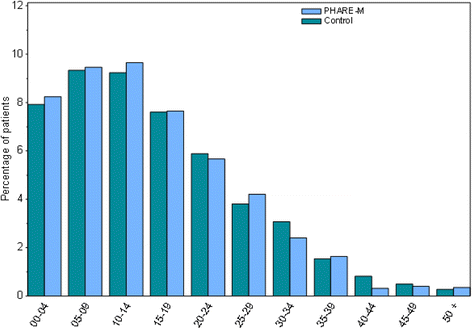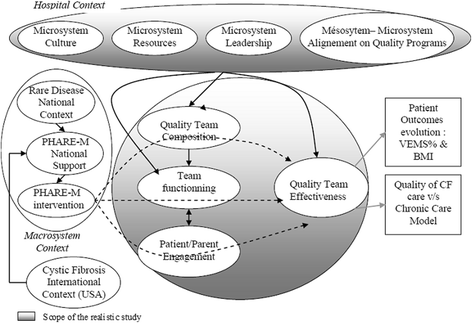Quality of care in cystic fibrosis: assessment protocol of the French QIP PHARE-M
- PMID: 29799381
- PMCID: PMC6225544
- DOI: 10.1186/s13023-017-0749-3
Quality of care in cystic fibrosis: assessment protocol of the French QIP PHARE-M
Abstract
Background: The PHARE-M care quality improvement program, modeled on the US Cystic Fibrosis Quality Improvement Program, was introduced at 14 cystic fibrosis centers (CFCs) in the French Cystic Fibrosis Network between 2011 and 2013. The pilot phase assessments attested the progressive adherence of the teams and improvements in care management. The PHARE-M Performance research project aims at assessing in 2015 the impact of the PHARE-M program on patient health indicators at trained versus untrained centers. It also sought to identify contextual factors that could account for variability in the performance of the PHARE-M among the trained centers.
Methods: A mixed methodology combining: a quantitative experimental study: a comparison, using a mixed model for repeated data (from 2011 to 2015), of the average changes over time in forced expiratory volume in 1 s (FEV1) and body mass index (BMI) between two groups of patients included in a closed cohort (non-transplant patients, continuous follow-up at one participating CFC, and a CF-causing mutation), one having benefitted from the PHARE-M program and the other not having done so, and a realistic study: a characterization of the impact on care management and an identification of mechanisms through which the PHARE-M intervention improved the team's effectiveness in different CFC contexts; this required modeling the intervention, context, and impact on care management with respect to the criteria of the chronic care model (CCM); this was done using a self-administered questionnaire given to professionals and patients/parents supplemented with focus groups.
Conclusion: Although the study population was controlled, it may be difficult to establish a causal relationship between the differences in the changes over time in patient health indicators in the two groups of patients and the PHARE-M intervention as it is often the case in complex interventions rolled out in adaptive environments. The analysis of factors associated with variations in the impact of the PHARE-M at the different trained CFCs required the adoption of instruments validated in other contexts; these could be useful for assessing the performance of other interventions in healthcare practices at CFCs in France.
Keywords: Cystic fibrosis; Patient registry; Qualitative study; Quality improvement program; Quantitative study.
Conflict of interest statement
Ethics approval and consent to participate
Regulatory authorizations were granted for the quantitative research part focused on the patients’ personal health data: a favorable opinion from the Ethics Committee of the Brest University Hospital (CHU) (session on 13 May 2014) and a notification of authorization by CNIL for a change in data processing stipulating the addition of a new recipient of the Registry data within the framework of a care quality improvement program (DR2015040 on 16 February 2015).
Consent for publication
NA
Competing interests
The authors declare that they have no competing interests.
Publisher’s Note
Springer Nature remains neutral with regard to jurisdictional claims in published maps and institutional affiliations.
Figures
References
-
- List of CF-causing mutations. https://www.cftr2.org/sites/default/files/CFTR2_13August2015.pdf.
-
- Zemel BS, Jawad AF, Fitz Simmons S, et al. Longitudinal relationship among growth, nutritional status, and pulmonary function in children with cystic fibrosis: analysis of the Cystic Fibrosis Foundation national CF patient registry. J Pediatr. 2000;137:374–380. doi: 10.1067/mpd.2000.107891. - DOI - PubMed
-
- Committee on the Quality of Health Care in America, Institute of Medicine. Crossing the Quality Chasm: A New Health System for the 21st Century. Washington, DC: National Academy Press; 2001. Available at: http://www.nap.edu/catalog/10027.html.
Publication types
MeSH terms
LinkOut - more resources
Full Text Sources
Other Literature Sources
Medical




